Something I’ve always associated with Puckaway is feeding the birds. Richie always made it a priority; one of the first things we’d do upon arriving is open up the pole barn and fill some buckets with sunflower seed to stock the feeders. This was a way for me to pitch in and work with my grandpa even when I was too young or small to help with much else. The chickadees were so used to us that they’d eat out of our hands.
When Richie got older and his congestive heart failure started making even light work difficult, I’d drive up here ahead of him to take care of chores so he’d have nothing to do but relax and enjoy the place. Feeding the birds was always the first task on my list.
The first several years after Richie passed away, I didn’t do much of anything for the birds. Overnight stays outside of deer camp were rare, so I wasn’t even around to watch them come in. A lot of the feeders were falling apart and our general neglect of the property didn’t make the birds seem like much of a priority anymore. You could hear chickadees from the margins of the yard and there were signs of woodpeckers on every dead tree off of the driveway, but a lot of songbirds stopped coming in all together. It started to bum me out as just another example of how I couldn’t keep up with the place.
And then Jacob was born.
Suddenly, I’m in a new role. I’m a father to a son and he fills me with a powerful motivation to provide him the same magic place that I had as a kid. I spend as much time as I can over the next few years making improvements and beating back seasons of decay. Joshua is born and my dedication to reclaiming Puckaway grows even stronger. I start writing entries in the log again. The keep becomes as accommodating as it ever was when I was young, even more so. Puckaway starts to look like the idealized version from growing up that I always keep in my mind and heart.
All of the little victories and milestones that came with the improvements were satisfying, but it took a small yellow bird for me to feel like I truly brought this place back to how it was when I was a kid. It was April of 2016 and I had just set up a tall post for bird feeders. I had been keeping the feeders full since the previous summer, but was only bringing in a few varieties of birds. And then Lyssa spotted a goldfinch. I started choking up; it was the first one I’d seen here in almost 15 years. It’s strange how certain small things can hold such significance, but watching that bright little songbird was like hearing my grandpa tell me, “Thank you for taking care of Puckaway.”
We bring in all kinds of birds now. Jake’s getting good at naming them all on sight; he even knows most of the calls. Here’s a list of what you can expect to find at the feeders:
Chickadee
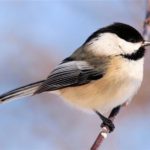 One of the most common birds in the area, you can hear these little guys calling all spring and summer long. They’re not picky and will eat from the feeders or on the ground.
One of the most common birds in the area, you can hear these little guys calling all spring and summer long. They’re not picky and will eat from the feeders or on the ground.
Chickadee
White-breasted Nuthatch
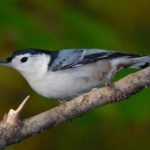 You’ll see these almost as often as the chickadees, but they prefer to stay up off the ground.
You’ll see these almost as often as the chickadees, but they prefer to stay up off the ground.
White-breasted Nuthatch
Goldfinch
 My personal favorite. And very easy to spot! I counted over a dozen on and around the feeder pole last summer.
My personal favorite. And very easy to spot! I counted over a dozen on and around the feeder pole last summer.
Goldfinch
Blue Jay
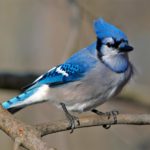 This guy’s hard to miss due to his size, bright colors, and the fact that most other birds scatter when one shows up to the feeders.
This guy’s hard to miss due to his size, bright colors, and the fact that most other birds scatter when one shows up to the feeders.
Blue Jay
Cardinal
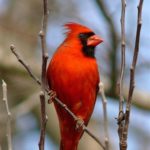 Another distinctive bird that’s pretty prevalent around the grounds. They’ve got a pleasant call, too.
Another distinctive bird that’s pretty prevalent around the grounds. They’ve got a pleasant call, too.
Cardinal
Dark-eyed Junco
 I love these little guys. They stay low to the ground and come in huge groups, cleaning up after the picky birds above.
I love these little guys. They stay low to the ground and come in huge groups, cleaning up after the picky birds above.
Dark-eyed Junco
Downy Woodpecker
 We get quite a variety of woodpeckers at Puckaway. This is one of the smallest and most common.
We get quite a variety of woodpeckers at Puckaway. This is one of the smallest and most common.
Downy Woodpecker
Hairy Woodpecker
 Just a little bigger than the Downy and even more common. These guys love the suet blocks I put out.
Just a little bigger than the Downy and even more common. These guys love the suet blocks I put out.
Hairy Woodpecker
Red-bellied Woodpecker
 About as big as a Blue Jay, these make quite a racket when coming in for suet. Their bright red heads really stand out.
About as big as a Blue Jay, these make quite a racket when coming in for suet. Their bright red heads really stand out.
Red-bellied Woodpecker
Pileated Woodpecker
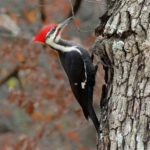 The big’un. Somewhat rare amongst the local woodpeckers. Almost the size of a crow and sporting a bright red mohawk, they’re hard to miss.
The big’un. Somewhat rare amongst the local woodpeckers. Almost the size of a crow and sporting a bright red mohawk, they’re hard to miss.
Pileated Woodpecker
Red-Winged Blackbird
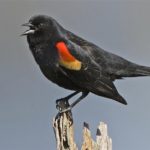 These guys are everywhere. Along the roads, in the marsh, by the river… and they hit the feeders in huge groups.
These guys are everywhere. Along the roads, in the marsh, by the river… and they hit the feeders in huge groups.
Red-Winged Blackbird
Rose-breasted Grosbeak
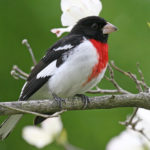 The chalk-white beaks on these birds are almost more striking than their white and red feathers. I don’t remember seeing them much growing up, so it’s pretty cool to be bringing them in now.
The chalk-white beaks on these birds are almost more striking than their white and red feathers. I don’t remember seeing them much growing up, so it’s pretty cool to be bringing them in now.
Rose-breasted Grosbeak
House Finch
 These birds came back with the goldfinches. They don’t stand out as much, but they’re still a welcome presence.
These birds came back with the goldfinches. They don’t stand out as much, but they’re still a welcome presence.
House Finch
Song Sparrow
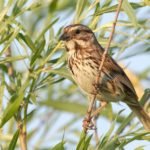 I could be misidentifying this one, but I’m pretty sure I’ve seen and heard a few come in and they seem common out in the marsh.
I could be misidentifying this one, but I’m pretty sure I’ve seen and heard a few come in and they seem common out in the marsh.
Song Sparrow
Cowbird
 Here it is, the only bird on this list I’ll shoot down. These feathered parasites lay their eggs in other birds’ nests, often destroying any existing eggs. I haven’t seen many since I started filling the feeders again and I hope it stays that way.
Here it is, the only bird on this list I’ll shoot down. These feathered parasites lay their eggs in other birds’ nests, often destroying any existing eggs. I haven’t seen many since I started filling the feeders again and I hope it stays that way.
Cowbird
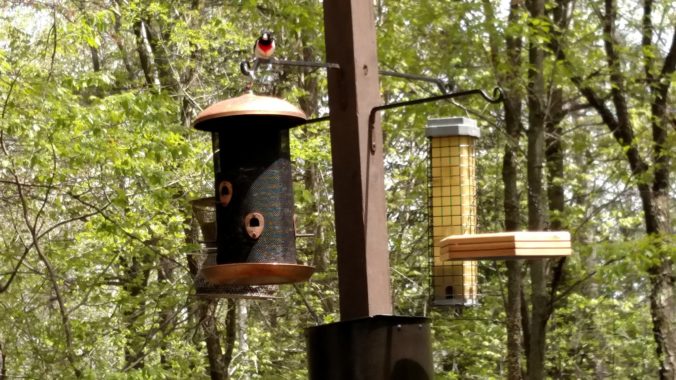

Leave a Reply
You must be logged in to post a comment.